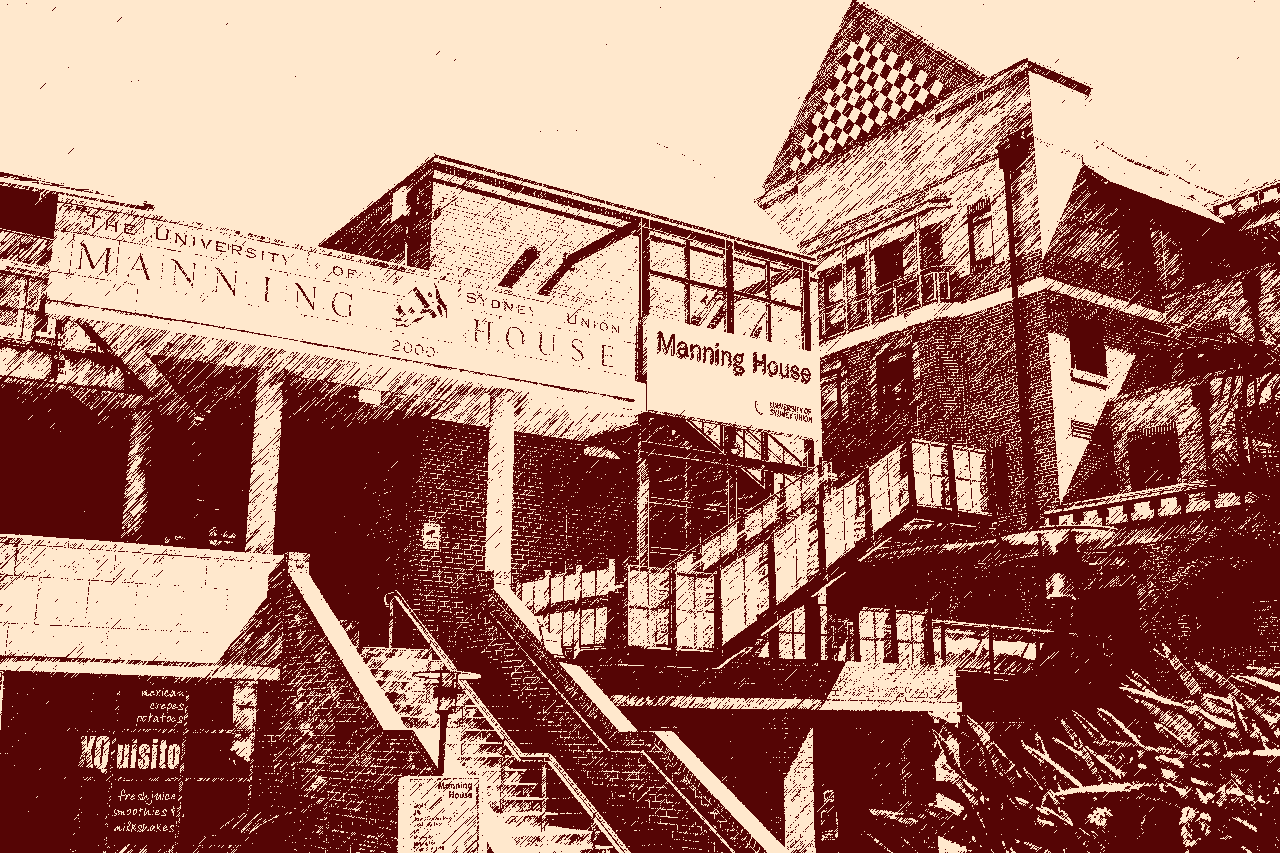The past few years have been devastating for the live music industry. Many of us are still waiting to see gigs we had booked for the start of 2020. Despite coronavirus restrictions easing in New South Wales, live music will remain affected by singing and dancing bans until late February.
The impending closure of the Lansdowne Hotel was a further reminder of the sorry state of the industry. While we will miss feeling the floorboards thump upstairs at the Lansdowne, it is important to remember that the fantastic music venue of Manning Bar is nestled within our campus.
Manning once held the beating heart of campus life. It was open for daytime trading and acted as a space for students’ post-class mingles and a way to get to know their classmates. Recall the legendary moment when Leonardo DiCaprio was spotted enjoying a cold beer on the balcony in 2011 while in Sydney to film The Great Gatsby. Devastatingly, in late 2019 the University of Sydney Union (USU) Board unanimously voted to stop daytime trading at the venue.
In 2017, students fought desperately to save Manning when management was being handed over to entertainment group Century Venues. The organisation has been an industry leader for over 30 years and is currently in charge of other Sydney favourites such as Enmore, Factory and the Metro Theatre. Manning was once a mecca for students by students, emerging from the quirks and culture of its patrons. In exchange for Century’s professional clout, this distinctive quality was lost.
Manning is no longer a space where students seize control of the environment but a sterilised husk where everything is meticulously designed and controlled, losing the intricacies and imperfections that gave Manning its soul.
While stripped of its role as a student bar, it still hosts some of the most impressive Australian and international live music acts. Endowed with a rich musical history, Manning continues to provide fans with a chance to see some of their favourite artists up close and personal in an intimate environment where the thrills of live music truly captivate.
Manning has been a crucial venue for the Australian music scene, hosting then up-and-coming acts like Paul Kelly in 1979 and INXS in 1980. This trend has continued with Australian favourites such as Lime Cordiale, Ball Park Music, Violent Soho and Slowly Slowly having held shows at Manning in the past few years. This list is by no means exhaustive. Manning has been a key entry point for many Australian artists who held smaller shows at the venue before skyrocketing to success. Tame Impala and The Cat Empire performing in 2009 come to mind.
As well as this, Manning has been the leading venue for several music festivals, including the Sydney Guitar Festival in 2018. It was also a pioneering venue for the Hardcore festival that started in 2004.
What strikes me about Manning is the way that it acts as a hub for outsider music and bands with cult followings. The venue gave a platform to bands whose music is not played on the radio or seen in the charts but still widely appreciated in niche online circles and crowd-sourced reviewing sites such as Rate Your Music. Some of these groups include no wave group Swans, midwest emo outfit Tiny Moving Parts, shoegaze-black metal band Deafheaven and hyperpop artist Dorian Electra.
Manning’s ability to attract bands with a devoted cult following may be due to its size. Spacious enough to hold a decent amount of concertgoers making international tours viable yet small enough to foster intimate performances.
Although the venue attracts a diversity of genres such as hip hop (The Beastie Boys, Stormzy, $uicideboy$ and Freddie Gibbs), shoegaze (Swervedriver and Alcest) and pop rock (Foo Fighters and The Black Keys). However, punk, hardcore and metal seem to be most at home at Manning Bar. The venue has been a staple on tours of Australian punk icons Frenzal Rhomb and Radio Birdman and has attracted acclaimed international punk acts such as Misfits, Dead Kennedys, NOFX, Bad Brains and Propagandhi. The venue also hosts some of the world’s most interesting and avant-garde metal outfits such as Sunn O))), Sleep, Animals as Leaders and noise rock duo Lightning Bolt.
I was lucky enough to attend one of the few shows held at Manning Bar in 2021, seeing 90s Australian skate punk outfit Frenzal Rhomb. After attending a Manning punk gig, I completely understand the appeal.
For those who haven’t been to a show here, let me paint a picture. Upon ascending the staircase, you will see a musty red carpet (crucial for any live music venue) and a lowered pit of lightly coloured floorboards. Taking raving seriously, Manning builds its mosh in a literal pit. The sunken pit also makes Manning a more accessible venue as it is easy to see the performers even from the back of the crowd. However, if you are inside the pit, as soon as one beer gets spilled on the wooden floors, it becomes closer to an ice skating rink than a music venue. While to some this may seem terrifying, to 40-year-old punk dads with piercings, mohawks, and Doc Martens fighting to keep the punk dream alive, this represents an unmissable moshing experience.
When I was in this mosh being pummeled from side to side, I could not help but think of the irony that come Monday morning, I would be sitting calmly in my philosophy tutorial – located a mere fifty metres away.
Manning’s continued dedication to exceptional music, domestic and international, popular or with a cult following, speaks to its promise as a venue. However, if we want Manning to avoid the same fate as the Lansdowne, we must reclaim it for ourselves.





